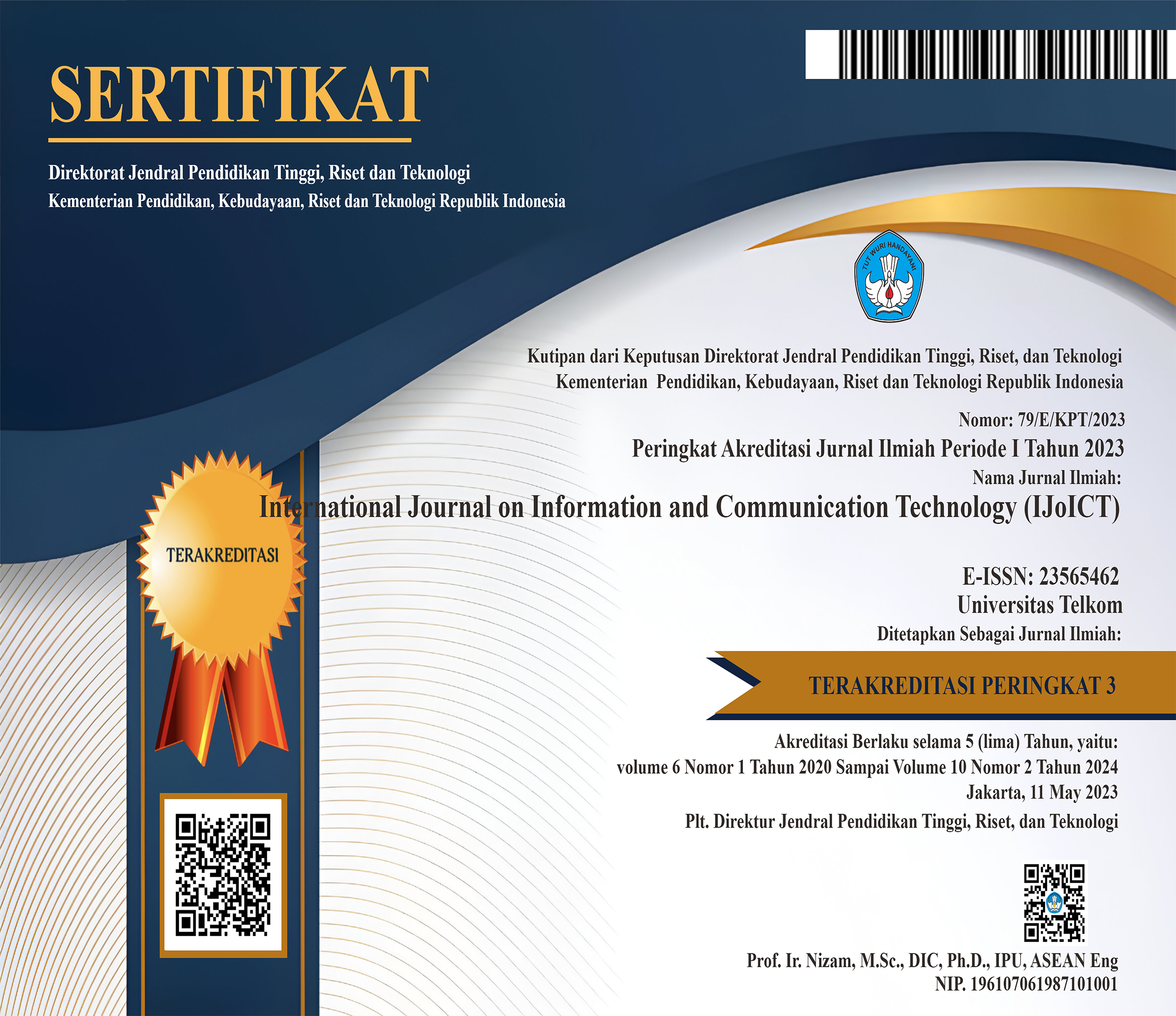Increasing the Security of RFID-based Classroom Attendance System with Shamir Secret Share
 Abstract views: 612
,
Abstract views: 612
,
 PDF downloads: 376
PDF downloads: 376
Abstract
This paper proposes an attendance system for increasing the security based on Shamir Secret Share algorithm. The use of RFID devices for classroom attendance is still vulnerable to certain attacks. Students usually make use of existing loopholes for prohibited things, such as forged attendance. Shamir Secret Share is a security method based on the Secure Multiparty Computation (SMC) concept. The SMC guarantees not only the confidentiality of external attacks but also of each member in the secure system. In the attendance scenario using Shamir Secret Share, a student and a lecturer must do tapping at the same time; otherwise, the secret that opens the lock for attendance at that class will not be opened. To realize this system, this paper uses two RFID modules, each of which is connected to one nodeMCU microcontroller. Both systems are connected to a database where the Shamir Shared Secret calculation is performed. Some experiment has been implemented for proving the concept. The result shows that some scenarios of fraud in RFID based attendance can be prevented.
Downloads
References
S. Singh, A. Kaushik, and S. S. Chitkara, “Ubiquitously controlled personalized smartlock,†Proc. Int. Conf. IoT Soc. Mobile, Anal. Cloud, I-SMAC 2017, pp. 686–691, 2017.
Y. M. Hwang, M. G. Kim, and J. J. Rho, “Understanding Internet of Things (IoT) diffusion: Focusing on value configuration of RFID and sensors in business cases (2008–2012),†Inf. Dev., vol. 32, no. 4, pp. 969–985, 2016.
S. L. Ting, A. H. C. Tsang, and Y. K. Tse, “A framework for the implementation of RFID systems,†Int. J. Eng. Bus. Manag., vol. 5, no. 1, pp. 1–16, 2013.
T. S. Lim, S. C. Sim, and M. M. Mansor, “RFID based attendance system,†2009 IEEE Symp. Ind. Electron. Appl. ISIEA 2009 - Proc., vol. 2, no. Isiea, pp. 778–782, 2009.
M. Burmester, J. Munilla, and A. Ortiz, “Comments on ‘Unreconciled collisions uncover cloning attacks in anonymous RFID systems,’†IEEE Trans. Inf. Forensics Secur., vol. 13, no. 11, pp. 2929–2931, 2018.
F. Kerschbaum and N. Oertel, “Privacy-preserving pattern matching for anomaly detection in RFID anti-counterfeiting,†Lect. Notes Comput. Sci. (including Subser. Lect. Notes Artif. Intell. Lect. Notes Bioinformatics), vol. 6370 LNCS, pp. 124–137, 2010.
M. Meghdadi and A. A. Azar, “The Possibility of Using RFID System to Automate and Integrate the Attendance of Professors and Students in the Classroom,†Intell. Control Autom., vol. 07, no. 04, pp. 93–109, 2016.
P. Tan, H. Wu, P. Li, and H. Xu, “Teaching Management System with Applications of RFID and IoT Technology,†Educ. Sci., vol. 8, no. 1, p. 26, 2018.
P. Sihombing, J. Timanta Tarigan, A. Khair, and H. Rumapea, “The Student Attendance Controlling by Using RFID (Radio Frequency Identification) to Increase the Time Optimization and Accurate of Data,†J. Phys. Conf. Ser., vol. 1235, p. 012039, 2019.
J. S. Cho, Y. S. Jeong, and S. O. Park, “Consideration on the brute-force attack cost and retrieval cost: A hash-based radio-frequency identification (RFID) tag mutual authentication protocol,†Comput. Math. with Appl., vol. 69, no. 1, pp. 58–65, 2015.
S. Piramuthu, “On Existence Proofs for Multiple RFID Tags,†no. June, pp. 317–320, 2006.
T. Dimitriou, “A lightweight RFID protocol to protect against traceability and cloning attacks,†Proc. - First Int. Conf. Secur. Priv. Emerg. Areas Commun. Networks, Secur. 2005, vol. 2005, pp. 59–66, 2005.
S. Nath, P. Banerjee, R. N. Biswas, S. K. Mitra, and M. K. Naskar, “Arduino based door unlocking system with real time control,†Proc. 2016 2nd Int. Conf. Contemp. Comput. Informatics, IC3I 2016, pp. 358–362, 2016.
Z. Zhi-yuan, R. He, and T. Jie, “A method for optimizing the position of passive UHF RFID tags BT - RFID-Technology and Applications (RFID-TA), 2010 IEEE International Conference on,†no. June, pp. 92–95, 2010.
M. Andriansyah and M. Subali, “e-KTP as the Basis of Home Security System using Arduino Uno,†CAIPT, pp. 1–5, 2017.
K. V. Seshagiri Rao, Pavel V. Nikitin, and Sander F. Lam, “Antenna design for UHF RFID Tags: A review and a practical application,†IEEE Trans. Antennas Propag., vol. 53, no. 12, p. 3870, 2005.
A. Shamir, “How to share a secret,†Commun. ACM, vol. 22, no. 11, pp. 612–613, 1979.

This work is licensed under a Creative Commons Attribution 4.0 International License.
Manuscript submitted to IJoICT has to be an original work of the author(s), contains no element of plagiarism, and has never been published or is not being considered for publication in other journals. Author(s) shall agree to assign all copyright of published article to IJoICT. Requests related to future re-use and re-publication of major or substantial parts of the article must be consulted with the editors of IJoICT.









.png)

.jpg)




